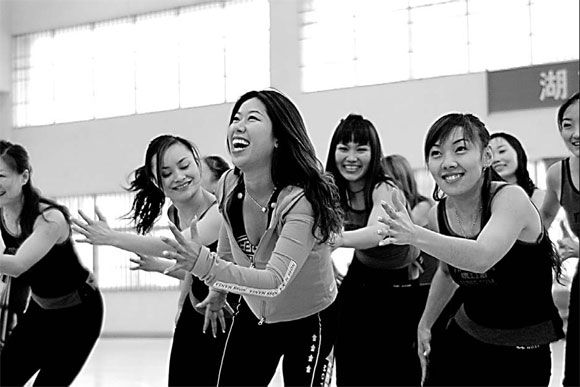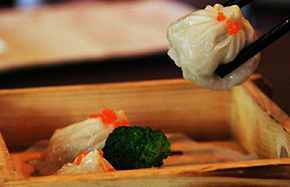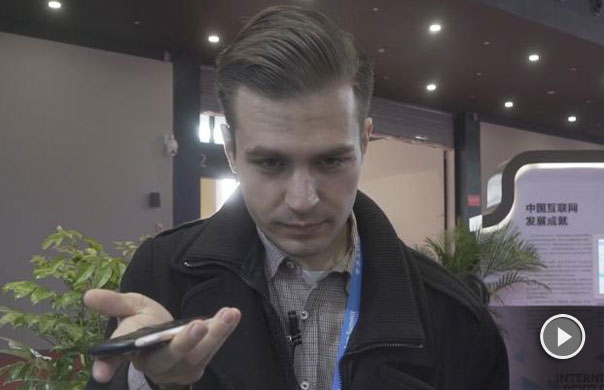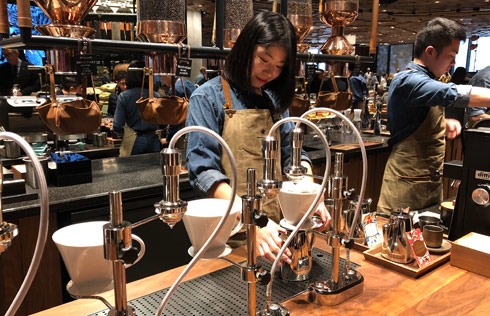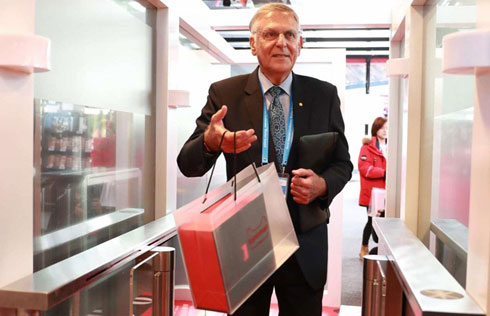Give me a Cho!
|
Soojin Cho (middle and below) dances with members of her Soojin Dance Team. Photos courtesy of Soojin Cho |
She's been dubbed bold and vigorous by the local media, crowned the "sexy goddess on the sports arena" and hailed the "cheerleader of China's cheerleading cause". During training she is a hard taskmaster and vents her fury at teammates. But most of the time, she's easy-going and likes nothing more than playing throw-and-catch with her two dogs.
South Korean Soojin Cho was one of the first foreign trainers to set up exercise classes in Beijing's gyms. In recent years, more people have got to know her through her Soojin Dance Team and their energetic cheering performances at sports events, such as the Chinese Basketball Association (CBA) games and "Good Luck Beijing" pre-Olympic events.
Born in 1974, Cho, a native of Incheon, was among the first wave of South Koreans who came to China in the early 1990s.
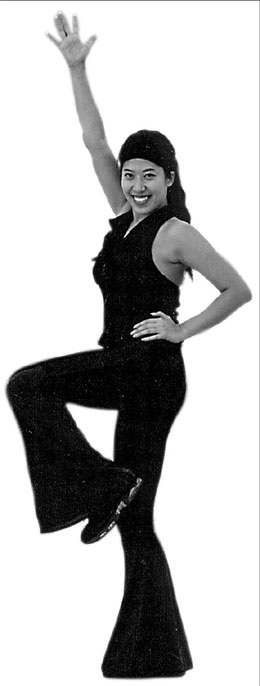
"The two countries just established diplomatic relationship. Compared with the craze of studying English and Japanese, few Koreans could speak Chinese," Cho says.
She decided to go to China to study because the tuition here was less expensive, however another reason for moving to the Middle Kingdom was her name. Her father had always reminded her that their family name originated in China.
"Cho is a rare family name in South Korea. It is believed that my ancestors surnamed Zhao in China, and they changed Zhao to Cho after settling down in South Korea," she adds.
Cho arrived in China in the winter of 1994 and back then, there was no direct flight between Seoul and Beijing. She first took a flight to Tianjin, then a bus to the capital. She remembers a gray and overcast sky, not many skyscrapers and horse-drawn carts on the roads.
While undertaking a four-year course at the University of International Business and Economics, Cho also worked as a part-time trainer in a nearby gym. "I loved dancing when I was a little girl. I started to practice aerobic exercise at 14. I have always wanted to be a distinctive trainer of aerobic exercise," she says. "I wanted to build up my career here in China."
Her class was very popular and attracted 60 to 100 attendants, four times more than any other instructor.
"The reason why they liked my class was not only because I am a South Korean. I know how to spice up the class and mobilize people, while many other trainers simply follow routine movements," she says.
She starts her class by asking people to close their eyes and recollect what they've done in the day. Sometime she plays South Korean pop music. She teaches sophisticated movements but never stresses accuracy of people's movements.
"The main tasks in my class are to laugh and cry out loud," she says. "It was difficult for them at first. Asians are reserved and reluctant to express their feelings in public."
She tries to make people laugh by telling jokes in her broken Chinese, teasing them and making faces.
Cho's class is often filled with laughter and her unorthodox methods has earned her the nicknamed of "crazy" trainer.
"It is like a pop gig. Attendants have great fun and feel relaxed in my class. Many of them say that I helped them become more confident," she says.
Upon graduation in 1998, Cho continued to teach exercise classes in Beijing's gyms. Her courses and her trademark laughing-and-crying approach was well received. But some professionals criticized her methods for not paying attention to detail. Others questioned her qualifications and claimed she behaved like a nightclub dancer.
"I take the role of trainer as a serious and life-time practice. All I am doing is drawing inspiration from different training methods around the world and to construct a suitable one for the Chinese," she says.
In 1999, Cho founded the Soojin Dance Team and the earliest members were seven regular attendants of her gym class.
At first, they performed for themselves and later scored a few commercial jobs. It was not until the 2002 FIFA World Cup in Japan and South Korea that the team became celebrated on an bigger scale.
The event drew an influx of Chinese spectators because it was the first time the Chinese national team had ever entered the final round at the World Cup. "However, I found that there was no professional cheering squad from China, besides the self-organized cheering teams of football fans," Cho says, who was a cheerleader in school.
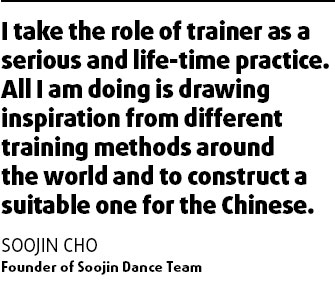
Cho and her team became stars when they appeared in the stadium wearing chic sportswear and designs of the Chinese national flag painted over their faces.
They waved rattle-drums and led spectators to cheer for the Chinese football team, making front-page headlines in South Korea. "People, particularly in my home country, wondered why a South Korean girl was leading a Chinese cheering squad. Actually I didn't think about it much. I stayed in China for several years. I simply wanted to do something to unite the Chinese spectators," she says.
During their tour in South Korea after the World Cup, Cho published a book about her life in China, encouraging her female compatriots to strive for their ideals.
"In my country, girls are taught to be qualified wives and mothers. I hope South Korean women can take more initiative in public affairs, and they can enjoy the bitterness and sweetness during the pursuit of their own career like I do in China," she says.
Cho was designated the head coach of CBA's cheering squads between 2002 and 2004.
"I knew nothing about basketball. It didn't matter. I believed that a good cheering team should try their best to interact with the spectators and spice up the field."
She had only two weeks to revamp CBA's cheering squad, whose previous performance was criticized for being boring and conservative like the morning exercises in China's school.
"When we performed on the opening game of CBA's new season, a lot of spectators were stunned, their eyes and mouths were wide open," she says.
"They shouted, applauded and broke into cheers. And after the show, I heard some one saying: 'We finally have a real cheering team'."
She signed another contract with the CBA in 2005. Before resigning, she went to the United States and watched several NBA games and took notes.
"Maybe we don't have to follow the example of NBA. We need to create a cheerleading culture of our own," she says.
Cho has interviewed many girls aspiring to join cheer squads and says many see the job in a wrong way, thinking all they need is a beautiful face and a hot body.
"To be a good cheerleader, you should first display positive attitude toward the job. You should be devoted to strict training and high-intensive exercises, so that you can look healthy and energetic before the spectators," she says.
Cho now devotes herself to her dance team, which has undertaken many cheer performances during the ongoing "Good Luck Beijing" competitions. These include beach volleyball, handball and wheelchair basketball.
The team is gearing up for their biggest performance in August.
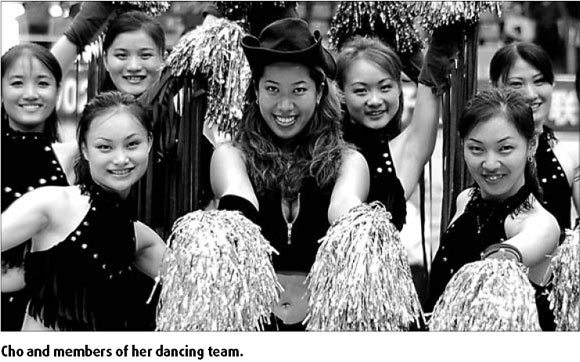
(China Daily 01/22/2008 page20)


